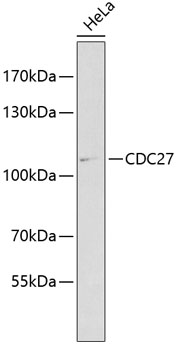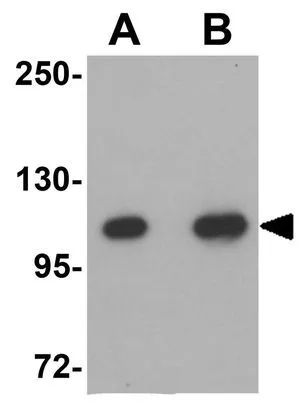CDC27 antibody [AF3.1]
GTX10538
ApplicationsImmunoFluorescence, ImmunoPrecipitation, Western Blot, ELISA, ImmunoCytoChemistry, ImmunoHistoChemistry, ImmunoHistoChemistry Paraffin
Product group Antibodies
TargetCDC27
Overview
- SupplierGeneTex
- Product NameCDC27 antibody [AF3.1]
- Delivery Days Customer9
- Application Supplier NoteWB: 1-2 microg/ml. *Optimal dilutions/concentrations should be determined by the researcher.Not tested in other applications.
- ApplicationsImmunoFluorescence, ImmunoPrecipitation, Western Blot, ELISA, ImmunoCytoChemistry, ImmunoHistoChemistry, ImmunoHistoChemistry Paraffin
- CertificationResearch Use Only
- ClonalityMonoclonal
- Clone IDAF3.1
- Concentration~2 mg/ml
- ConjugateUnconjugated
- Gene ID996
- Target nameCDC27
- Target descriptioncell division cycle 27
- Target synonymsANAPC3, APC3, CDC27Hs, D0S1430E, D17S978E, H-NUC, HNUC, NUC2, cell division cycle protein 27 homolog, D0S1430E, D17S978E, anaphase promoting complex subunit 3, anaphase-promoting complex, protein 3, cell division cycle 27 homolog, nuc2 homolog
- HostMouse
- IsotypeIgG2b
- Protein IDP30260
- Protein NameCell division cycle protein 27 homolog
- Scientific DescriptionCdc27 shares strong similarity with Saccharomyces cerevisiae protein Cdc27, and the gene product of Schizosaccharomyces pombe nuc 2. It is a component of the Anaphase Promoting Complex (APC), which is composed of eight protein subunits and is highly conserved in eucaryotic cells. The APC catalyzes the formation of the cyclin B-ubiquitin conjugate that is responsible for the ubiquitin-mediated proteolysis of B-type cyclins. This protein and 3 other members of the APC complex contain the TPR (tetratricopeptide repeat), a protein domain important for protein-protein interaction. This protein was shown to interact with mitotic checkpoint proteins including Mad2, p55CDC and BUBR1, and thus may be involved in controlling the timing of mitosis.
- Storage Instruction-20°C or -80°C,2°C to 8°C
- UNSPSC12352203
References
- Senese S, Cheung K, Lo YC, et al. A unique insertion in STARD9's motor domain regulates its stability. Mol Biol Cell. 2015,26(3):440-52. doi: 10.1091/mbc.E14-03-0829Read this paper




![IHC-P analysis of lung cancer tissue (left) and colon cancer tissue (right) using GTX82818 CDC27 antibody [5C12].](https://www.genetex.com/upload/website/prouct_img/normal/GTX82818/GTX82818_20170912_IHC-P_w_23051501_413.webp)

![Western blot using Affinity Purified anti-cdc27 antibody (GTX41386) shows detection of a band ~90 kDa corresponding to human cdc27 (arrowhead). Approximately 35 ug of HeLa whole cell lysate was separated by SDS-PAGE and transferred onto nitrocellulose. After blocking the membrane was probed with the primary antibody diluted to 1.0 ug/ml for 2 h at room temperature followed by washes and reaction with a 1:10,000 dilution of IRDye800 conjugated Gt-a-Rabbit IgG [H&L] MX for 45 min at room temperature. IRDye800 fluorescence image was captured using the OdysseyR Infrared Imaging System developed by LI-COR.](https://www.genetex.com/upload/website/prouct_img/normal/GTX41386/GTX41386_20160330_WB_w_23060820_577.webp)
